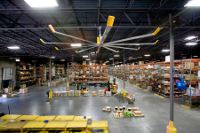Large diameter, low speed fans efficiently circulate air throughout an entire space, from floor to ceiling and wall to wall. Depending on the fan's speed, this gentle, nondisruptive airflow both cools in the summer and improves heating efficiency in the winter.
Let's take a closer look at large diameter, low speed fans, and how they work year round.

Because these big fans use their immense size -- not speed -- to move a massive amount of air, they require minimal electrical input to run. Using the fans in conjunction with HVAC, it is not unusual to save 25% or more on energy bills by circulating air throughout the space, creating uniform temperatures and reducing the need for HVAC. (Shown right, the Powerfoil X from Big Ass Fans.)
Summer Cooling
In the summer, fans provide an additional boost to air conditioning systems. Because the perceived cooling effect of air movement can make a person feel up to 10°F cooler, managers can raise their air conditioning setpoint and utilize energy-efficient fans to make up the difference. Customers and employees will feel the same level of comfort, which the building can maintain with far less energy.
Large fans can be added to many existing structures, where they often are used to help qualify the building for energy-saving incentive programs. In new construction, specifying large fans when the HVAC system is designed can also help facilities eliminate a significant amount of ductwork, saving on initial building costs before the fans are ever turned on.
DPR Construction's Phoenix Regional headquarters is a showplace for the sustainable building practices DPR is committed to bringing to the community and their clients. The net-zero office utilizes large overhead fans, operable windows, a solar chimney, and shower towers to keep its workforce comfortable while minimizing electrical consumption.
"As the building starts to warm up and the temperature climbs, the fans speed up," Andy Hill, preconstruction manager and sustainability specialist, explained. "All of the system works together until the temperature inside reaches a setpoint around 84 deg. Then, the windows shut down and the dampers close, but the fans stay on and our mechanical cooling turns on.
"[The fans] are a huge component to our passive cooling comfort system. It would not work without them," Hill said.
Winter Heat
Stratification occurs because hot air is approximately 5-7% lighter than cool air in a space and tends to rise to the ceiling. In the winter, large diameter fans can be used to destratify heat by moving large volumes of warm air off the ceiling without creating a draft. The steady mixing of air creates a uniform temperature throughout the space, which can help the heater to maintain the same thermostat setpoint with less effort, resulting in a serious reduction of operating costs.
Unlike small ceiling fans that struggle to send air to the floor and only create insignificant pockets of air movement, large diameter, low speed fans gently mix air to stabilize air movement without creating a draft in winter, using patented airfoils and winglets to allow the fan to operate in the forward direction without causing a draft.
Federated Co-operative Ltd. of western Canada used large diameter, low speed fans to decrease the rate at which their buildings were shedding heat.
"We noticed a pretty significant decrease in natural gas consumption," said Trevor Carlson, manager of Environmental and Technical Services. "We believe we saved $19,800 in the first year in natural gas consumption as a result of the fans. That's a payback of approximately 3 years on the project."
Conclusion
By efficiently moving serious air, large diameter, low speed fans provide summer cooling and winter heat recirculation -- and serious savings all year round.





